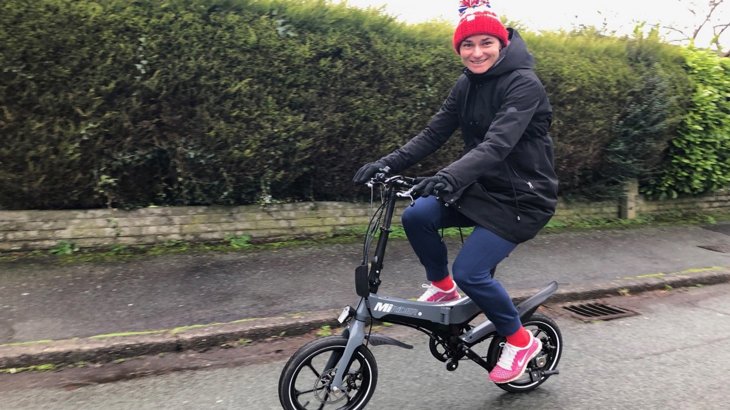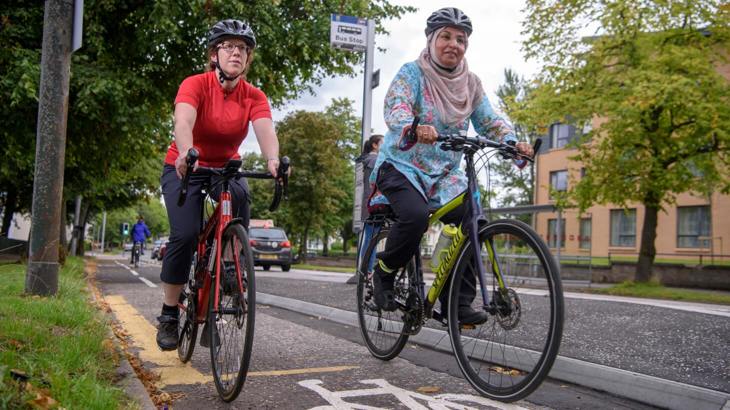The number of women cycling and walking increased during the first Covid-19 lockdown. But there's still so much more we need to do to make it safer for women to cycle for their everyday journeys. Dame Sarah Storey takes a look at the latest research and shares what she thinks needs to be done to see permanent change.

Safety is still the main cited reason as to why women don't regularly cycle.
Shortly before taking on the role of Active Travel Commissioner in the Sheffield City Region, I spoke on behalf of research British Cycling had commissioned.
It found that two-thirds of women cited safety as a reason for not cycling regularly.
Now almost 2 years into my role in South Yorkshire and I would say this remains one of the biggest reasons why we still don't see as many women cycling as we do men.
Looking at the stats
That's not to say that men aren't as affected by safety concerns.
But when there are fewer women cycling in the first place, the idea of being confronted by a huge SUV whilst trying to navigate a painted advisory cycle lane, puts anyone new off from trying.
Shortly after taking up my position in South Yorkshire, the 2019 Bike Life report from Sustrans further highlighted the gender gap in cycling, with 76% of women never cycling.
But 36% of those who don't say that they would like to if they felt safe.
Lockdown saw a rise in women cycling
In fact, when that safe feeling arrived, back in the first lockdown of the covid-19 pandemic in the spring of 2020 when traffic levels dropped to figures not seen since the 1950s, we saw an enormous rise in the number of women taking to cycling.
And the anecdotal evidence from talking with bike shop owners is that they have seen more women through their doors in the past 12 months than in any other year.
With fewer vehicles on the road and specific instruction from the Government to only leave home in the car for a small number of essential journeys.
For the first time in their adult life, people felt safe enough to venture out on their bike.
We can't lose this momentum for cycling
The benefit of this rise in cycling uptake was that more people were able to experience the world from their cycle.
More people could put themselves in the saddle of another person out cycling and now more people are hopefully looking out for people on their bikes.
That's not to say our roads are feeling any safer, and as we start to look at a route back to normal life.
But while public transport capacity remains limited, there are more and more people, especially women, leaving their bikes for use only when they can drive to a safer feeling place.
It's vital we don't lose their enthusiasm for these active journeys and build and plan more infrastructure that will enable them to feel safe again.
We need to make drivers more aware of other road users
We must also tackle the elephant in the room, which is the greatest threat of harm.
Too many road safety campaigns target a potential victim.
They advise them on how to be seen and fail to confront the fact it is a driver who must conduct their vehicle in a manner that doesn't threaten or risk the life of a vulnerable road user.
Not enough emphasis is put on the potential for a vehicle to be turned in to a lethal weapon when in the hands of an irresponsible driver.
Footways also need improving
It's not just about creating safe spaces for people cycling, because footways are not the safe haven for people walking that they should be.
We can't genuinely expect to get more people on their bikes unless we address the issue of footways being prioritised as parking spaces, storage for signs, storage for vehicle charging points and all manner of other furniture that is designed purely for the benefit of drivers.
Guard railings guide people on foot to one place so they can cross for the convenience of a driver.
And crossings are designed to maximise the speed of a vehicle journey, with no regard for how long the journey of a pedestrian is going to take.
Footways are inaccessible to people in wheelchairs and parents pushing buggies.
But we don't often see an outcry of indignance from these groups as we've been trained to shrug and accept that we can't do anything to impede the path of a motor vehicle.

It's vital we don't lose people's enthusiasm for active journeys built during the pandemic. We need to build and plan more infrastructure that will enable them to feel safe.
Changing the common stereotype of a 'cyclist'
This International Women's Day, I'd like us to commit to changing two things.
Firstly we need to change the common stereotype conjured up when the word "cyclist" is used.
A quick image search on the internet brings up pages and pages of pictures of men on racing bikes in lycra, with women only visible if it's something connected to their image.
A cyclist is simply a person, any person, riding a bike of two, three or four wheels and the purpose of their journey could be for sport, but most likely for transport.
Representing the image of cycling for the general population is a vital way we can ensure women see other women riding their bike and start to associate it as being a journey making option for them too.
Most pedestrians are women
Secondly, we must acknowledge those people who have shouldered the brunt of the inconvenience in their journeys for too long and commit to changing this situation.
Women make up the highest proportion of pedestrians and are more likely to use walking for a journey than men.
It's time these journeys were valued for the benefit they have to communities.
And by looking after the needs of the pedestrian, slowing down vehicles and removing vehicle priority, roads will feel different and make way for more people to feel safer to cycle again.
Of course, measures that support women in active travel will benefit men too, so it's a win-win for everyone.
Read our blog on how places that are designed with women’s needs and travel habits in mind are places for everyone.





